The TTC Board will consider the final version of the 2022 Service Plan at its meeting on February 10, 2022.
See:
- 2022 Annual Service Plan
- TTC 2022 Service Plan (my previous article on this subject, October 2021)
- CEO’s Report for February 2022
To avoid duplication, I will only discuss here items which are new in this version.
The big system-wide change coming later in 2022 will be the opening of Line 5 Crosstown and the restructuring of the surface network. The proposals are the same as in the draft version of the plan, and I will not discuss them here.
[Page numbers cited in this article refer to those within the “glossy” version of the Service Plan which follows the covering report at p. 18 of the linked pdf.]
What Riders Want
One page from the plan is really a vital part of the whole discussion. Some riders want better connectivity, but a good chunk of this is about service quality and quantity. Sadly, there is little in the TTC’s plans that will address this issue beyond restoring service more-or-less to pre-pandemic levels.
Those of us who remember the “before times” will know that simply putting back bus, streetcar and subway hours is not enough. There were problems with service before covid, and the pandemic shuffled what had been a growing debate off the table.
Ridership recovery, let alone growth, will require that transit be as good as it can be, not merely good enough to get by.

Focus and Priorities
The Service Plan lists the TTC’s priorities for 2022 [at p.14].
- Improve regular scheduled service by reallocating and restructuring services
• Optimize service levels, on all routes, at all times of day, based on demand;
• Operate Line 5 and improve connections to the surrounding bus network; and
• Restructure services to respond to customer travel patterns. - Maintain demand-responsive service
• Operate flexible buses to respond to changes in customer demand; and
• Operate flexible buses to minimize customer inconvenience due to service disruptions. - Advance key strategic initiatives
• Continue implementing surface transit priority measures such as queue jump lanes and transit signal priority;
• Pilot cross-boundary service integration in partnership with neighbouring municipalities; and
• Enhance connections to complementary modes of transportation, including walking and cycling.
Nothing here speaks to service quality and reliability, a long-standing issue on the TTC.
The 14x Downtown Express routes and the 176 Mimico GO will continue to be suspended.
As detailed in a previous article, there will be extensions of 8 Broadview, 65 Parliament and 118 Thistle Down. A new peak route 150 Eastern will add service in the eastern waterfront, and 172 Cherry will make a seasonal reappearance replacing the route 121 service to Cherry Beach. Other than route 172, there is no date announced for these service changes.
Line 1 Yonge University Spadina will switch fully to Automatic Train Control probably late in 2022. The timing is related to changes at Eglinton Station for the Crosstown which will shift the train stopping location further north. The TTC plans to implement one person operation over the entire line, and the Service Plan notes that speed and reliability will be improved. The details of a speed change have not been announced along with whether this will translate to higher capacity or a reduction in the trains needed to provide service.
The TTC plans to add timed connections at major transfer points between 300-series Blue Night routes, but there are no details for this.
Ridership Recovery
The rate of ridership varies from one part of the system to another. This is shown in the map below. Until the most recent return to more restrictive rules, the areas in dark green, all of which are served primarily by the bus network, had recovered 55-65 percent of their pre-pandemic traffic.

This corresponds with locations where there is a high proportion of workers who must be on site. In the map below, note that these key employment areas (pink) are generally not the same as the Neighbourhood Improvement Areas (green) where those of lower incomes reside, although they are nearby.
In part this is due to decades of city planning that treated zones for housing separately from zones for work.
There is no guarantee that someone working in a “pink” area will live in the immediately adjacent “green” one, and a network of routes is required to handle all of the travel between them. The map shows many lines (pink) where the TTC provided supplementary demand-responsive service in 2021.
Many hospitals and grocery stores are not in “essential” employment areas. This shows the danger of flagging specific areas rather than looking at the map overall. Much of the city is not formally identified as NIAs. Transit planning through a “lens” that only considers these areas will have a lot of blind spots.

Weekday ridership was recovering at different rates for each mode as of mid-November.
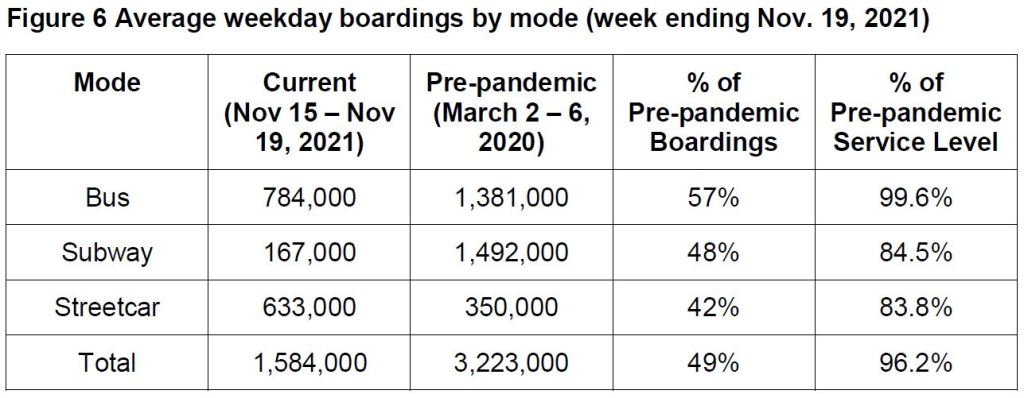
Late in 2021, TTC demand dropped off as shown in these charts from the February 2022 CEO’s report.
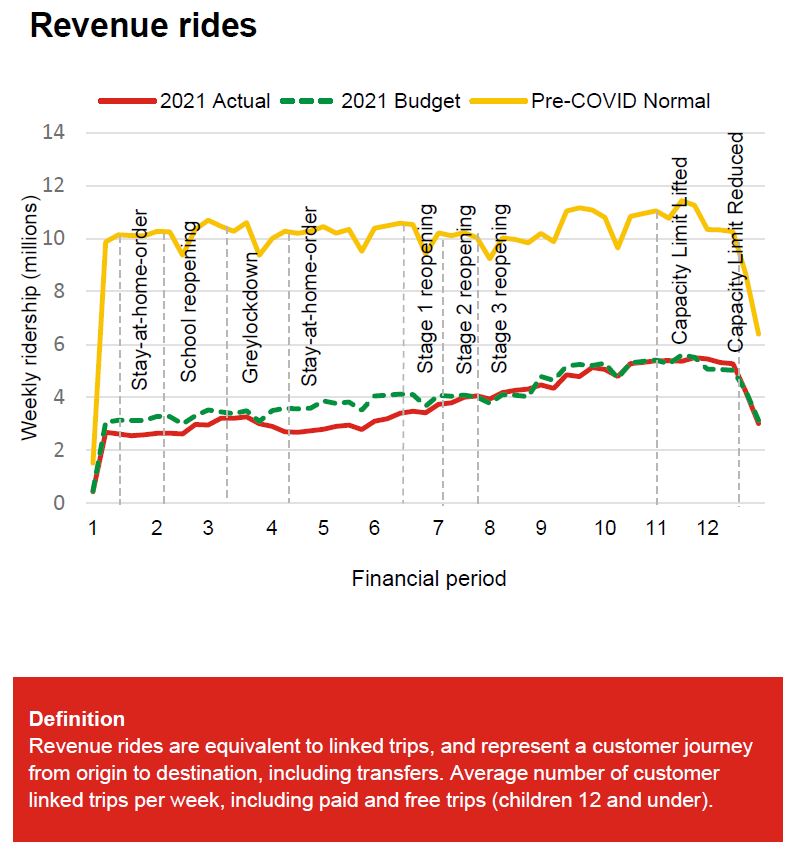
Boardings (unlinked trips) also fell as shown below. The drop took streetcar and subway boardings back to mid-2021 levels, and buses even further. Note that some of this drop could also be seasonal.

By late January, demand was picking up again, although not yet at the same level as in November. This is seen in the uptick of average bus occupancy.

How Many Riders Will There Be?
While it is tempting to foresee a permanent drop in transit use if one’s outlook is that work from home will take over, planning on that basis would be foolhardy. The TTC’s adjusted budget for 2022 takes into account an “omicron dip” followed by a recovery to previously projected levels. The chart below was part of the TTC’s budget presentation to the City.

The version in the Service Plan is less optimistic about Q1 and Q2 in 2022.

The level of planned service is based on 100 per cent of the pre-pandemic level adjusted for the Line 5 Crosstown opening. There is also an adjustment for lower demand and availability of operators in the first quarter. Overall, the number of hours for 2022 will be slightly lower than for 2021, but this is primarily due to the lack of full service in Q1.
The total hours planned are shown in the first chart below followed by the detail of the year-over-year changes. Note that the first chart shows modes reading down, while in the second the modes read across.

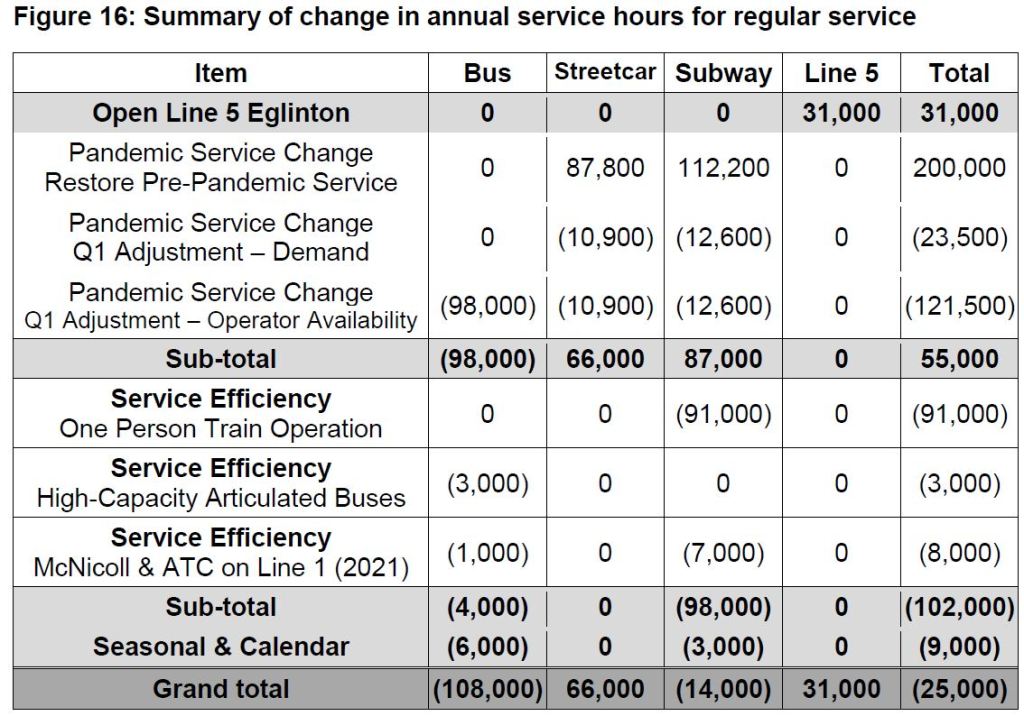
Assuming that this plan holds, there will be an opening pressure on 2023 to operate full service for a 12-month period both to make up the Q1 adjustment in 2022 and the full year’s service in Line 5 Crosstown.
Fleet Plan
The TTC plans a gradual growth in peak service over coming years as shown in the table below breaking down the changes by mode.
The growth in buses is small because there is an offset from buses replaced by the new Lines 5 and 6, as well as the end of construction on those corridors, and recovery of some vehicles from streetcar routes as the fleet returns to full strength and additional cars are delivered.
Some buses will be released by the Crosstown opening, and more from reduction of bus needs on streetcar lines due to construction and a shortage of streetcars. This is an unusual year with the KQQR project still only partly completed as well as the late completion of water main work on Broadview. The actual service levels and changes with the Crosstown route have not been announced and will probably not be available until the months before opening day.
This table does not show any provision for extra vehicles in support of the city’s Net Zero 2040 plans which foresee a substantial increase in transit service, nor for the replacement of LIne 3 with bus service. This is of some concern because the capital budget already has a large amount of unfunded fleet-related spending. A report on the NZ2040 requirements will be included in the TTC’s 2023 budget cycle according to a recent City Briefing Note.
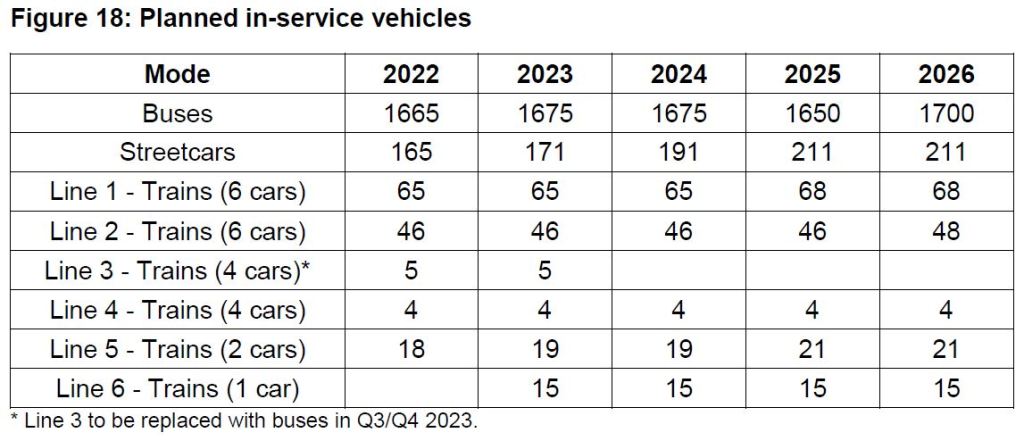
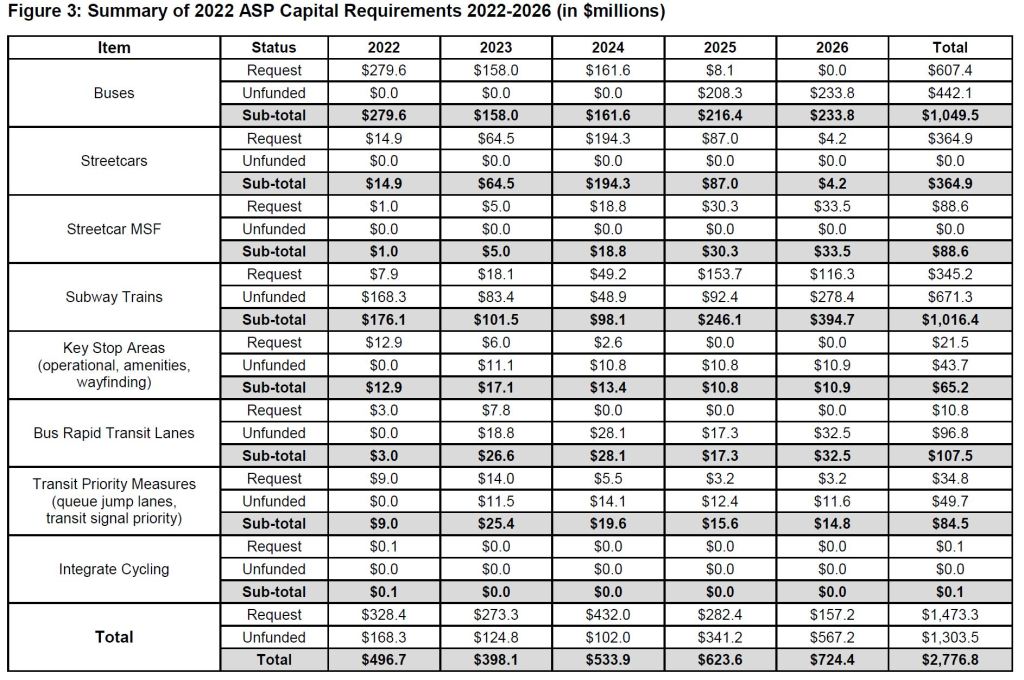
Streetcar Infrastructure Renewal and Expansion
The planned streetcar infrastructure projects in 2022 are shown in the map below. Note that track on Adelaide from Charlotte (east of Spadina) to Victoria eastbound will be restored in 2022 as part of an overall reconstruction of Adelaide Street by the City. This track will be used for the planned diversion of the Queen Street services during Ontario Line construction between Bay and Victoria. The diversion will only run east from York, but restoring a continuous diversion all the way to Spadina will be useful for other diversions, notably for TIFF.
Plans call for the intersection at York to include curves north-to-east, east-to-north and south-to-east.
Similar foresight was not included for the intersection of Carlton and Church where only the existing curve in the southwest quadrant will be rebuilt, and the missing curves on the southeast quadrant will not be added. This has been an ongoing problem with TTC intersection projects where adding curves for flexibility in diversions is often forgotten. Another fairly recent example was Broadview and Gerrard where a once-planned north to west curve was missed. These opportunities come up about once every quarter century.
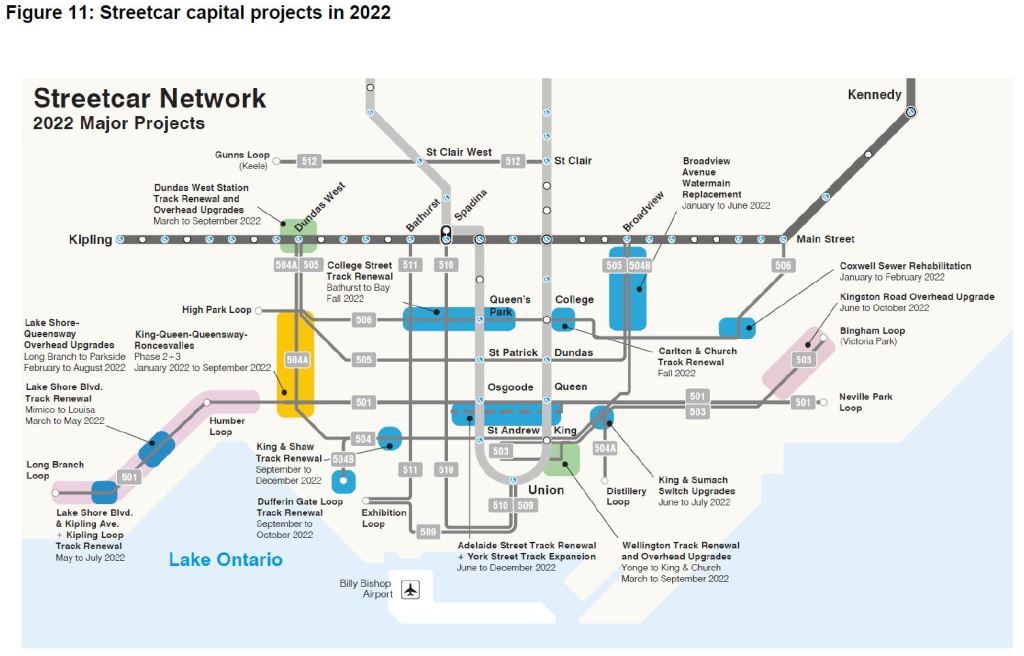
416-905 Cross-Boundary Travel
The TTC plans to pursue cross-boundary service integration in 2022, but this will initially be on a very small scale with trial operations on Burhamthorpe (MiWay) and on Dufferin North (YRT). The claim is that this will allow for improved service and reduced duplication. This is of course related to the proposed elimination of the cross-boundary fare zone. One would hope that any integration occur without having to make two separate changes to the tariff.
Cross-boundary operation has legal hurdles (changes to the City of Toronto Act) and labour relations issues (exclusivity and contracting out). The latter issue is currently in arbitration.
Resolving operational and fare collection issues is only part of the challenge of regional travel. There is no indication on this map of the relative level of service and the origin-destination pattern of cross boundary trips. Fare and route integrations are only first steps.

Average vs Specific Statistics Can Mislead
An important but overlooked issue in the TTC’s analysis and presentation of crowding and other statistics is the difference between averages and individual values. Riders do not travel on average buses and their experience can vary widely from TTC claims.
The TTC crowding chart showing the percentage of trips at various crowding levels are based on individual trips, but do not split out this information by route or time of day.
The following chart shows the average demand for routes by time period. Each dot is one route. Based on this, only a few routes carry more than the target number of riders.

The problem with averaging is that, as any transit rider knows, service is not regular and crowding conditions vary greatly from one vehicle to another. This can produce stats that under-report the problem’s severity.
Consider six buses with loads varying from 50 to 0 passengers by increments of 10. That is to say, six buses with loads of 50, 40, 30, 20, 10 and 0 riders. The average load is 150/6 or 25 passengers and this looks rather good in the aggregate.
However, 120 of those riders (80%) are on half of the buses. This means that the “typical” experience, what most riders actually see, is crowded buses. The 30 riders on two uncrowded buses will think everything is just fine while the operator of the empty bus will have an easy job indeed.
The chart of busy routes by time of day may have most dots below the 100% line, but these are average values within each route and do not pick up bus-to-bus variations.
Meanwhile, the TTC has no tracking (or at least no reporting) of how “demand responsive” buses are used and whether they are strategically inserted or simply sent out in the hopes they will fill gaps and add to useful capacity.
I will return to the subject of bus service quality and bunching in future articles.

They plan on street closings for the Gerrard & Riverdale/Lesile Stations, we should be building detour streetcar tracks on Dundas Street East (between Broadview Avenue and Carlaw Avenue) and on Carlaw Avenue (between Gerrard Street East and Queen Street East). Afterwards, the 505 Dundas streetcar will be able to be rerouted to Gerrard Station with an on-street loop, with tracks on Carlaw Street available for streetcar detours.
Steve: Once upon a time, in an early version of the Relief Line, there was going to be a loop at Gerrard Station for an extended Dundas car. It was cut to save money on the project.
I am still working through all of the details in the draft EA, and on top of that there is a TTC board meeting this week. Never a dull moment here!
LikeLiked by 1 person
Thanks Steve, as always for your thorough and timely analysis. One thing that leapt out at me was the number of vehicles scheduled for Line 5 Eglinton. The chart says 18 in 2022, then going to 19 and finally (just) to 21 in 2025. I realize these are two car trains, but they ordered and have received 76 cars (38 two-car trains). I know they must have spares but they’re only planning on running 36-42 cars (18-21 two-car trains) for the foreseeable future??? What kind of headway would that would provide? We also don’t know if they’re still planning on short-turning every second train at Laird so the tunnel section has the more frequent (2X) service.
Steve: According to a backgrounder on the Crosstown site, the one way time from Kennedy to Keele would be 38 minutes. Let’s say another 3 minutes to Mt. Dennis and at least 2 for turnaround/recovery time. That’s 43 minutes one way, or 86 minutes round trip. That’s a headway of just over 4 minutes with 21 trains, or 15 trains/hour. The projected peak demand by 2031 is 5,500/hour or about 370 per train which is pushing things a bit. At least they have lots of spare cars if demand surprises them.
LikeLiked by 1 person
Steve, do you have any details on what the plan is for the Dufferin North corridor? Is the plan just to allow YRT 105 to pick up and drop off south of Steeles addidng to service on TTC 105 or for all service south of Steeles aside from service past midnight to be provided by YRT ?
Steve: Here is the plan for the initial rollout as described in the TTC’s report on cross-boundary integration at page 2:
LikeLike
Thanks Steve. As you note, there is no mention of “route management” (or lack thereof) as a cause of customer dissatisfaction. This really is a TTC blind-spot and, god knows, one you point out in every route analysis you prepare!
I was a bit surprised that the new 150 bus is routed on King Street between Parliament and York. King already has a lot of TTC traffic and it might have been better to route it, at least westbound, along Front to York and then back west by King/Parliament/Eastern.
I was disappointed (but not surprised) that the ‘planners’ (I use the term lightly!) forgot about adding the extra curve at Church/Carlton. This (like the Broadview/Gerrard one) was approved by the Board several years ago! Perhaps a “Commissioner” might ask about it?? :->
Is it clear yet if the new southbound track on York will go all the way to King Street or if it will end at Adelaide. The last block from Adelaide to King is short and it would surely add to flexibility if it went to King (or at least if the York/Adelaide track allowed for it to be added when the King track is relaid in 2024(?)
Steve: The southbound track on York ends at Adelaide. I believe that the road redesign for York does not foresee a southbound track to King.
LikeLike
There is a joke that explains this difference. Let nobody say that mathematicians lack a sense of humour. Here is the joke:
Jeff Bezos walks into a bar. On the average, everyone in that bar is now a billionaire.
LikeLiked by 2 people
The entire area around Front and Yonge to York is hopelessly clogged by personal vehicles. King gets backed up by blocked intersections, but at least there’s decent control along the blocks.
Plus we don’t know what sort of service TTC intends to run there. For all we know it’ll be every 20-30 minutes at peak.
I’m half expecting the local councillor to push for the 150 to be extended out to Neville Park in name of “network connectivity” and function as a regular-fare 143 in disguise. The downtown expresses were moved to King Street shortly before pandemic.
LikeLike
Interesting to speculate why the King / Sumach intersection is being rebuilt after just a few years of service. Is this the result of noise complaints from neighbours?
Steve: Yes, and possibly some track geometry issues.
LikeLiked by 1 person
Is there anything that would ever prompt TTC to look at adding new track to the network – to expand it, or, offer diversionary routes like what’s happening on Adelaide east of Spadina?
I know waterfront is waiting, along with areas east – but was just curious about it. Dundas seems obvious – but, so to do a bunch of streets around the network that could be used to expand.
Steve: I very much doubt it. Adelaide has been talked of for years, but I suspect that it is only being done because Metrolinx is paying for it At least they’re going all the way to Spadina.
LikeLike
Do you know when the TTC is going to replace those old non-pan friendly overhead cables on King Street West between Dufferin and Bathurst Steve?
Steve: Nothing is shown in their plans, but it’s an obvious location. It could be done without fully suspending service as the TTC did in some other locations, but whether they will take that approach remains to be seen.
LikeLike
Interesting that 8 Broadview is being extended south to Coxwell Stn. I wonder if that was ever thought of before since the route was cut back to its current looping in the 1960’s.
LikeLike
I am continually impressed at how the TTC manages to scrape together numbers (if you want to call it data) to produce these reports, whilst can’t seem to figure out service reliability and line management. I can’t help thinking they make up the numbers knowing that those who sit on the committee don’t care to read the reports nor have any understanding of what is happening in reality.
LikeLike
There has been some chatter about the issue of subpar-TTC culture and operation culture creeping onto Line 5 (or as I prefer: The Crosstown) and how the existing streetcar operations culture will eventually lead to poor operations on it. Is there any chance that this will happen or will Metrolinx be dictating the operations culture on The Crosstown? Specific comments have been regarding stop-and-approach/crawl over switches etc.
Steve: It would be ridiculous if streetcar operating tactics including slow orders at special work crept onto Line 5 because it has full double-blade switches just like the subway. Within the tunnels, the line will run on ATC and speeds will be set by the signal system.
A related issue will be whether the TTC can maintain the projected travel times and, if not, who pays for extra service to make up the difference.
It is extremely frustrating that the TTC issues blanket slow orders rather than flagging specific locations where there are problems. Imagine if they did this in the subway. It would be a scandal, but on the streetar system nobody seems to care.
Second question, has Line 1 (YUS) service been fully restored to pre-pandemic levels? I can’t remember if it was or not. If it has been, it clearly does not look like it when one is actually taking the subway. Operations seem to be purposely throttled and with some massive gaps happening during rush hour and 7-8pm ranging from 5-9 minute waits.
Steve: No, service is not back at pre-pandemic levels. YUS is running at 3’30” all day except late evenings when it goes to 5’00”. (BD is not at pre-pandemic levels either.) In January 2020, peak service on YUS was 2’21” AM and 2’36” PM. Midday was 3’49”, evening 3’30” and late evening 5’00”.
There have been problems with the changeover between one person and two person crews at St. George because the single step-back in the current schedule does not give enough time for operators to reach the other end of a train (i.e.: moving from the southbound train cab a the east end of the platform to a northbound train with the cab at the west end of the platform, 500 feet away. Effective this coming Sunday, February 13, this arrangement will change to a double step back and, in theory, “operational delays” at St. George should be reduced. This is an example of a TTC “own goal” in scheduling.
LikeLike
I am beyond happy to see 81 Thorncliffe Park service extended into Flemingdon Park and to Science Centre Station realized; a very big deal for students and families on both sides of the Overlea Bridge.
Similarly, the retention of 88 South Leaside service into Thorncliffe, now with service to Lines 1 and 5, continues the historical relationship between the two communities and offers Thorncliffers easier access to employment opportunities in the west end.
It was a pleasure to work on behalf of the community to achieve this, with dedicated support from Councillor Robinson and her team, great enthusiasm from TTC service planning, and a solid partnership with the Leaside Residents Association.
LikeLike
Biggest mistake is for Metrolinx to be turning over operation of the Eglinton LRT to TTC. They should turn it over to GO Train. This MIGHT smarten up TTC employees. Maybe.
LikeLike
Turning the Eglinton LRT over to Metrolinx would be a bigger mistake. The problem with the TTC is that it is UNDERFUNDED in its operations. The TTC has the highest farefox recovery compared with other North American transit agencies. Ever since the PC’s dropped the operation subsidy under Mike Harris, everything has to be penny-pinched, postponed, lowest bidder, or given up.
LikeLiked by 1 person
I dunno. GO doesn’t have experience with this newfangled technology of trains powered by electricity from overhead wires…
LikeLiked by 1 person
Any word on the exact opening date of Line 5?
Steve: No.
LikeLike
Line 1 needs to be split into TWO lines. Maybe using Union Station as a cross-platform transfer. They’ll need to tear down the wall between the current University platform and the Yonge tracks. They could use the current north tracks (currently Vaughan bound) for just the Yonge Line 1 trains, and the current south tracks (currently Finch bound) for just the University Line ? trains.
The present Line 1 is just too long. If there is a problem anywhere on Line 1, the entire line is affected. It would get worse with Line 1 being extended into Richmond Hill.
Steve: There was a proposal decades ago to split the lines, but it would have been very difficult to fit in the necessary trackage and platforms. In any event, this is now moot as it would be impossible to make the necessary changes given competing underground structures.
LikeLike